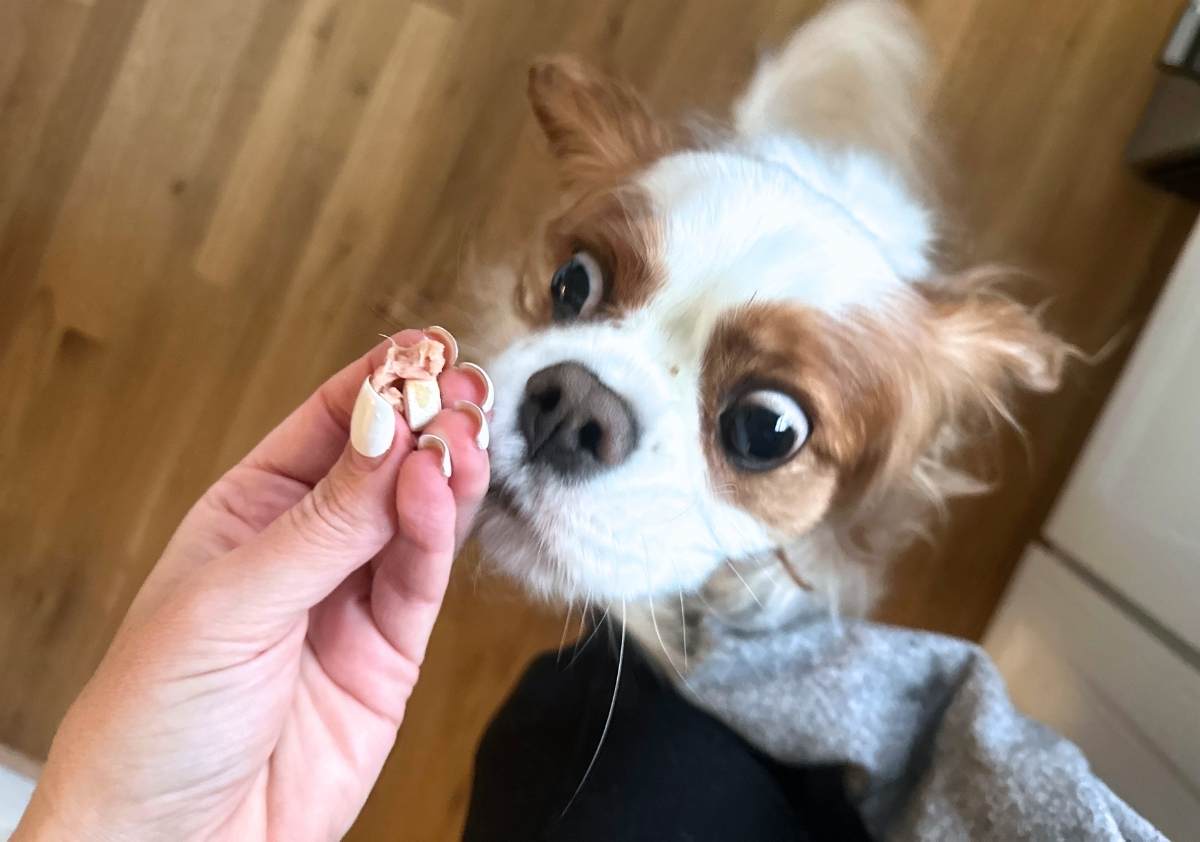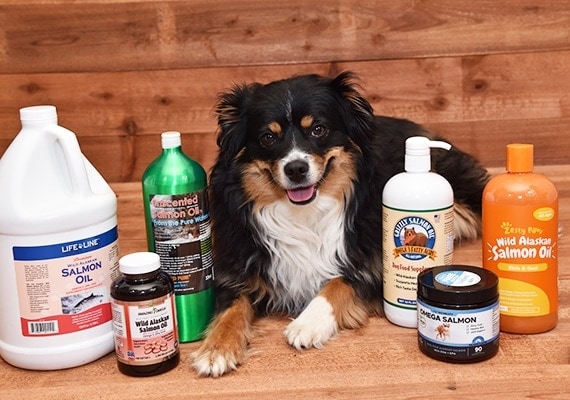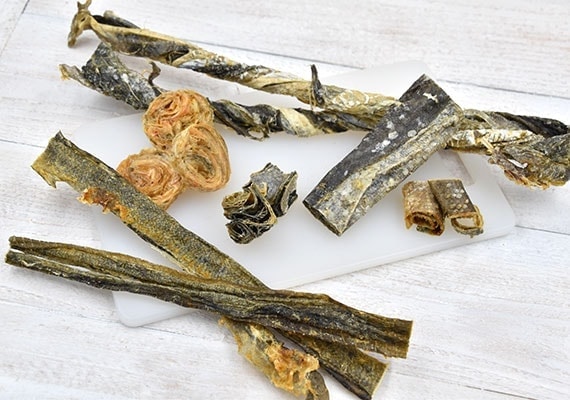To keep the lights on, we receive affiliate commissions via some of our links. Our review process.

Medicating our furry friends can often be challenging, especially when they are adept at detecting pills hidden in their food. My dog Georgie knows when there are pills he doesn’t want in his bowl, eating around them or accidentally eating them and spitting them out.
It got me wondering: What can I hide my dog pills in? I’ll share how to disguise pills for dogs safely, including walking you through our personal trials and insights to help you make the medicating journey more enjoyable for you and your furry friend.
The Challenge
Whether your dog is undergoing a short-term treatment, requires long-term medication, or is taking their monthly preventive flea and heartworm pills, administering meds to dogs can be a daunting task. Dogs have a strong sense of smell and taste, so many (including mine) have an uncanny ability to detect medications, even when cleverly concealed in their favorite treats. Finding creative ways to administer pills can make the process smoother for both you and your canine companion.
How To Hide Pills For Dogs:
There are a few traditional ways you can trick your dog into taking their meds using food. But my dog is often too smart and knows better, detecting and spitting out the pill before it’s swallowed. So we resorted to food. Having tried these methods, I can share what works for our dog (and what doesn’t).

One popular and convenient option is the use of commercial pill pockets. These are specifically designed to encase medication and resemble a treat while masking the pill’s scent and taste. While often effective, some dogs can become suspicious of these over time.

For a more personalized touch, consider making homemade pill pockets. Just mix together three ingredients: rolled oats, water, and peanut butter. Stir the batter until it’s a dough-like consistency (you might need to grind the oats in a food processor or blender first) and roll into balls. Use the end of a wooden spoon to create an opening, and keep the homemade pill pockets refrigerated so they don’t dry out.
What Foods Can I Hide My Dog Pills In
What can I hide my dog pills in? There are several safe foods you can use. Given his dietary restrictions, we tried all the ones we could! Let’s see how each went.
Cooked Or Boiled Chicken

The aroma and taste of chicken can often mask the scent and flavor of the pill, making it more likely that your dog will willingly consume it. Here are some steps to effectively hide pills in chicken.
Use lean cuts of meat to minimize fat content. Always avoid excessive oils and seasoning, as some spices can be harmful to dogs. While you may be tempted to use deli meats, these are high in sodium, and processed foods are not a very healthy option for pets, even in moderation.
For larger pills, you can create a small pocket in the chicken by making a slit with a knife. Insert the pill into the pocket. For smaller pills, you can wrap a small piece of chicken around the pill, ensuring that it is fully covered. Some dogs prefer warm or room-temperature chicken, so consider the temperature preferences of your furry friend.
Despite his love for chicken, Georgie follows a no-meat diet due to allergies. However, before we discovered this about him, chicken would have been our go-to.
| Pros | Cons |
|---|---|
| High Palatability: Most dogs love the taste and smell of meat, making it popular. | Cooking Time: Requires some time for preparation. |
| Nutrient-Rich: Provides protein, essential amino acids, and other nutrients. | Caloric Content: Moderation is key to avoid excessive calorie intake. |
| Customization: Can be easily cut into pieces for hiding pills. | Potential allergies: If your dog is sensitive to meat, this will not be a good fit. |
Cheese

What dog is not a sucker for cheese? Just wrap the pill in a small piece of cheese and watch your dog devour it without suspicion. Here are some tips when it comes to cheese.
Use mild, low-fat, or reduced-fat varieties, and select cheeses that are soft and easy to mold. This makes it simpler to wrap the pill in the cheese without leaving any trace. Some safe options include mozzarella, cheddar, or cream cheese. Avoid cheeses that are heavily seasoned or contain additives.
Cut the cheese into small, manageable pieces that are easy for your dog to consume. Ensure the size is appropriate for your dog’s breed and size. Wrap the pill in a small piece of cheese or encase it within a larger portion. If possible, cover the pill completely, masking both the scent and taste.
Monitor your dog’s response to ensure no digestive issues.
| Pros | Cons |
|---|---|
| Strong Smell and Taste: Many dogs find the strong aroma and flavor of cheese irresistible. | Caloric Content: Cheese is high in fat and calories, so it should be used sparingly, especially for dogs on restricted diets. |
| Versatility: Various types of cheese can be used, allowing for experimentation with different flavors. | Potential Lactose Sensitivity: Dogs with lactose intolerance may experience digestive issues. |
| Ease of Use: Can be easily molded around pills. |
Meatballs

Crafting small meatballs with the pill hidden in the center is another effective method. Ensure the meatball is of a size that your dog can comfortably swallow. Use lean meats like chicken, turkey, or beef to minimize fat content. Similar to chicken, avoid using any seasonings and sauces, especially those containing onions, garlic, or other ingredients that can be toxic to dogs.
Ensure that the meatballs are cooked thoroughly to eliminate the risk of bacterial contamination. If preparing meatballs at home, avoid frying them. Baked or boiled meatballs are preferable.
| Pros | Cons |
|---|---|
| High Appeal: Dogs often love meat-based treats, making them an attractive way to hide pills. | Texture Issues: Some meat treats may crumble easily, revealing the hidden pill. |
| Nutrient Content: Quality meat treats can contribute to a dog’s protein intake. | Caloric Considerations: Like cheese, meat treats may be high in calories and should be given in moderation. |
| Possible Sensitivity: Some dogs may have allergies or sensitivities to certain meats. Introduce meatballs slowly and monitor your dog for any adverse reactions. |
Peanut Butter

Hiding pills in peanut butter is a popular and effective method for administering medication to most dogs. The sticky texture and irresistible taste of peanut butter often make it an excellent choice. Peanut butter also offers versatility in the many ways you can trick your pup.
Use plain, unsalted, and unsweetened peanut butter. Avoid varieties that contain xylitol, as it can be toxic to dogs. Use an appropriate amount of peanut butter to cover the pill completely, but too much might make it challenging for your dog to swallow.
There are several ways to use peanut butter with pills. Spread a thin layer of peanut butter on a plate or your fingers. Place the pill in the center and cover it with more peanut butter, creating a “pill pocket.” Or mix the crushed pill with a small amount of soft dog food and then coat the mixture with peanut butter. This can help mask the pill further.
If your dog enjoys licking peanut butter off a spoon or from a dog-safe toy, spread the peanut butter on the spoon or inside the toy, then insert the pill. Place the peanut butter-covered pill inside a dog-friendly chew toy. This adds an element of play and can distract your dog while they consume the medication. Alternatively, you can wrap the pill in a small amount of bread or a soft treat and then cover it with peanut butter.
| Pros | Cons |
|---|---|
| Stickiness: Peanut butter’s sticky texture makes it effective for concealing pills. | Allergies: Some dogs may have allergies to peanuts. |
| Nutritional Value: It provides a source of healthy fats and protein. | Xylitol Concerns: Avoid peanut butter containing xylitol, as it can be toxic to dogs. |
| Calorie Dense: Adjust your dog’s regular meals to accommodate the additional calories and avoid overfeeding. |
Bananas

The sweet flavor of the banana can help mask the taste of the medication. Use ripe bananas that are soft and easy to mash. Peel and slice the banana into small, manageable pieces. Smaller pieces make it easier to conceal the pill. Use a knife to make a small incision or create a pocket in the banana. Then, insert the pill into the pocket and gently close it to feed.
You can also crush the pill into a fine powder and mix it thoroughly with mashed banana. This ensures the medication is evenly distributed, reducing the chance of detection. You can also freeze small banana treats with the pill hidden inside (check with the vet to make sure the medication can be frozen first). Dogs may enjoy the cool, refreshing taste while getting their medication.

| Pros | Cons |
|---|---|
| Natural Sweetness: Appeals to dogs with a sweet tooth. | Moderation: High in natural sugars, so feed in moderation. |
| Potassium: Contains potassium, which is beneficial for heart health. | Fiber Content: Excessive consumption may lead to digestive upset. |
| Easily Digestible: Gentle on the digestive system. |
Canned Tuna

Opt for canned tuna in water rather than oil to avoid excess fats, preventing potential digestive upset. Drain excess water to avoid a mess. Use a fork to flake the tuna into small, bite-sized pieces. This makes it easier to hide the pill and ensures even distribution. Form small balls or patties with the tuna and insert the pill into the center. Ensure the pill is completely covered.

You might also try combining the flaked tuna with plain, unsweetened Greek yogurt. The yogurt adds a creamy texture and helps hide the pill. Before introducing tuna, ensure that your dog doesn’t have any allergies to fish.
If your dog is accustomed to pill pockets, consider placing the pill inside a pill pocket and then wrapping it in a small amount of tuna fish.
| Pros | Cons |
|---|---|
| Strong Smell: The strong aroma can mask the scent of medication. | Mercury Content: Limit the frequency due to potential mercury exposure. |
| High Protein: Rich in protein, making it a nutritionally valuable choice. | Sodium Content: Choose tuna in water to avoid excessive sodium intake. |
| Convenience: Readily available in most households. |
Additional Tips For Hiding Dog’s Pills In Food

If you tried all these and are still having trouble, sometimes the most effective option is also the easiest – hide their pills in your dog’s favorite foods to camouflage the medication.
Having a finicky eater at home myself, I experimented with various methods to administer pills to my dog over the years. He requires daily medication as well as a multivitamin. Here are some things we’ve learned.
Whatever method you use, try to maintain consistency in the way you present the pills to create a positive association for your dog. You can also use the food as a treat without the pill occasionally to prevent your dog from becoming suspicious.
Offer the food-covered medication to dogs with enthusiasm and a positive tone. Dogs often pick up on their owner’s energy, so a cheerful demeanor can make the experience more enjoyable. Conceal the pill in the food discreetly. Dogs may be wary if they detect something unusual, so make it appear like a regular treat.
Before adding new treats or foods to your dog’s diet, especially if your dog has underlying health conditions, consult with your veterinarian to ensure it’s safe and appropriate. Always supervise your dog when introducing new treats to monitor for any signs of choking or difficulty swallowing. Also, watch for any stomach upset over the next 24 hours in case of digestive issues.
Conclusion
Creativity and adaptability are key in the quest to medicate our picky canine companions. Try different foods, noting your dog’s preferences and dietary needs. The ultimate goal is to turn the medication routine into a positive experience for your furry friend, strengthening the bond between you and ensuring their health and well-being. Remember, each dog is unique, so finding the perfect hiding method may require some patience. In the end, the joy of seeing your dog happy and healthy makes the effort worthwhile.
Tagged With:

